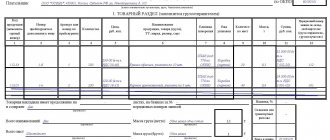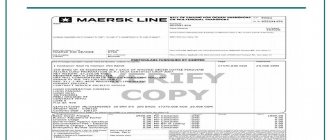The design of a packing list is used when transporting various types of goods. This is a shipping document drawn up in the form of an inventory that reflects the name of the transported inventory items, their quantity, weight, etc. options.
- Form and sample
- Free download
- Online viewing
- Expert tested
FILES
The list of information contained in the packing list may include any indicators of the cargo, except its cost.
This is quite natural, given the fact that the document is located outside the package and is easily accessible (i.e., without indicating the price of the product, the sender provides an additional measure for its safety). Roughly speaking, a random person will not know the price of the cargo.
When to Use a Packing List
The packing list is used when transporting goods with the help of transport companies - in this case, the use of this document, although not required by law, is often registered in the carrier’s accounting policies.
In the case of transporting inventory items abroad, drawing up a document is necessary (to present it at customs).
A packing list can be issued for a homogeneous cargo or a different product range packed into one product item (box, crate, pallet, bundle, barrel, etc.). It is located on the surface of the package in such a way that it can be easily found and familiarized with all the necessary information.
The packing list can be an independent document or serve as an attachment to an invoice, for example, if the weight, quantity and type of each item of goods are different or a large volume of inventory items is transported.
Number of seats
In cargo transportation terminology, a piece of cargo is a unit of measurement of cargo that the carrier considers. One place can be one box or one pallet or one box or bundle. Two pieces of cargo - maybe one box and one box. In documents for cargo transportation, 1 piece of cargo is entered as COLLI (colis). If the cargo is packed on pallets, write PLT. The carrier company transports the seats. For example, I took 10 pieces (boxes) for transportation and handed over 10 pieces. As long as the package remains intact and the number of places is the same, it doesn’t matter what happens inside. According to the CMR convention, the carrier is not responsible for internal (what is inside the container) damage. Do not file a claim with the carrier if you saved on packaging.
Why do you need a packing list?
The role of this document is quite simple: it serves as an integral annex to the transported cargo. Since the transported goods somehow pass through the warehouses of the logistics companies involved in its movement, it is mixed with other goods.
A packing list, containing all the necessary information and attached directly to the packaging, helps transport company employees quickly determine the integrity of the goods, navigate where exactly it is being transported, its quantitative characteristics, weight, etc.
This makes it possible to save time when sorting cargo, not to make a mistake with the destination of a particular product, and not to lose it at various stages of transportation.
Invoice
An invoice is included in the mandatory documents for cargo transportation. An invoice may also be called an “invoice”. The invoice reflects the fact of the transaction between the seller and the buyer. The invoice contains the name of the product, the quantity of each item, the price per unit, and the total amount to be paid. Be sure to indicate the date, number, names and details of the buyer and seller. Taxes payable are indicated separately. The invoice may also indicate the terms of the transaction, terms and methods of payment and shipment. An invoice is a key document for cargo transportation. An invoice is required during customs clearance of cargo. The efficiency of customs clearance depends (entirely!) on how correctly the invoice is drawn up. It is important for the carrier that the invoice for the goods transported is drawn up accurately and correctly.
Rules for drawing up a packing list
There is no specific, mandatory form for the packing list - the form can be designed in any form with the inclusion of any items that do not contradict the legislation of the Russian Federation. The main thing is that it contains:
- information about the shipper,
- recipient,
- exact destination address,
- form of packaging,
- the name of the goods being transported,
- its quantity and weight.
You should be careful when preparing the document, try to avoid mistakes, and if any do occur, it is better to draw up a new sheet. This is important because from the moment the cargo is accepted for transportation until the moment it is handed over to the receiving party, the carrier is responsible for the integrity of the inventory items.
Here it should be emphasized that the transport company is responsible for the integrity of the packaging, but it is not responsible for maintaining the quality of the goods during transportation.
In other words, if the customer saved on packaging and packed the goods in improper containers, then in the event of internal damage during transportation, it will be problematic to prove the carrier’s guilt.
Sample and established rules for entering information to fill out
Due to the large number of different types of goods, it becomes necessary to sign boxes, boxes and pallets with special packing slips. The use of documents saves time and resources in the process of shipping cargo consignments, eliminates misgrading with the emergence of situations when the client receives goods that were not intended for him. The safety of product names is verified, and the risk of losing cargo units when moving through the terminal is reduced.
A packing slip form is an official document that serves as a product accompaniment, and it is recommended that the papers be compiled only by qualified specialists. As a basis for the correct entry of data, a sheet compiled in free form can be used. There are also no actual regulations for the submission of data provided by the manufacturer.
Drawing up the document is relevant for cases where the cargo package may include goods of a different type. In situations where packing lists do not arrive with the goods or are lost during transportation, this fact may have a negative impact on the assessment of the reliability of the established value during the customs procedure.
When implementing freight transportation, the place is traditionally the unit of change of goods that the carrier undertakes to carry out transportation. An example is a box, crate or package. One box or drawer can be placed within one space. For designation purposes, the name COLLI is used. When packing goods on pallets, the PLT indication applies.
You should pay attention to the fact that the carrier transports exactly those places: he received 10 places and as a result handed over 10 places. Under the CMR convention, the carrier is not responsible for possible damage inside the container. Accordingly, for those situations where the product was damaged inside the formed packaging, the carrier’s side does not accept claims for consideration.
The sample packing slip provides an example of the information required to indicate. A special sheet is drawn up with the legal name of the company sending the goods, as well as the recipient of the products. The main field includes a table with the name of the goods and the number of units. In additional fields, marks are set with the number of boxes, gross and net masses.
Markers with container dimensions have been added, thanks to which you can calculate the space required for storing products. Information with the contract number, the date of its conclusion, as well as the date of drawing up the packing list must be indicated. The surname and initials of the general director - the person responsible for drawing up the document - are highlighted.
Video on the topic: “Packing list and filling it out”
Design rules
You can draw up a packing list on a regular A4 sheet, both printed and handwritten. In this case, the document must contain a “live” signature of the sender of the cargo, i.e. packer It is not necessary to certify the packing list with a seal, since from 2021 legal entities are completely exempt from the requirement to use stamps and seals in their activities.
The document is drawn up in at least two copies , one of which remains with the sender, the second is handed over to a representative of the transport company. If necessary, a third copy can be created and sent to the recipient of the cargo.
The legislative framework
The rotation of the packing list is regulated by several legislative documents. Since paper is used for transportation both within the state and abroad, the main provisions are described in the Customs Code of the Customs Union. In addition, regulatory regulation is carried out by the following documents.
- Berne Freight Convention for Railway Transport of 1985.
- Geneva Convention for Road Transport of 1975.
- Warsaw Convention for Air Services of 1955.
- UN Multimodal Transport Convention 1980.
- Federal law relating to the control of the transportation of goods by road.
Example of a packing list
- The name of the document is written at the top in the middle of the line, then below is the full name of the sending company.
- The following information is provided below:
- name of the recipient company,
- the address to which the cargo should be delivered,
- if necessary, a link to the main document is provided (in this case, it is an invoice),
- type of packaging
- the number of packages that the cargo occupies.
- Then there is a table in which the necessary parameters are entered:
- name of inventory items,
unit of measurement (pieces, liters, meters, etc.),
- quantity,
- weight.
- Under the table you should note weight of the goods (without packaging) and gross weight (respectively, in packaging).
- Finally, the document must be signed by the packer, as well as by the person who checked the packaging (usually a representative of the transport company directly involved in the transportation).
- The date the packing list was prepared is indicated at the bottom .
Also, special notes should be noted in the document: for example, about the fragility of the cargo, careful handling, etc.
How to register
The CMR form (international consignment note) is drawn up in at least four copies:
- for the sender;
- for the recipient;
- for the carrier company;
- for calculations.
If you plan to send one order on several vehicles or in several batches, the number of copies may be increased.
- Document for the cargo: as a rule, this is a packing list, designed according to a random sample.
In some special cases, along with these papers, additional ones will be needed: characteristics of the cargo, permission to transport, etc. This is usually due to the special nature of the material assets - hazardous chemicals, biological samples, etc.
Additional documents
Be prepared that in some cases customs authorities may request additional documents from you. This is done to determine the customs value of the goods. Mostly they ask for:
- export declaration of the sender (when importing goods);
- commercial offer of the seller (for import);
- manufacturer's cost estimate to confirm costs.
Keep records of exports and imports using the simplified tax system in the Kontur.Accounting web service. Currency accounting and work instructions, taxes, automatic salary calculation and reporting in one service
Certificate of Origin
The certificate of origin of the goods is included in the mandatory list of documents for cargo transportation.
Certificate of origin of goods is a document on a special form, with a description of the goods and confirmation from the government body that the goods for which the certificate of origin is issued were produced or processed in the country on behalf of which the specified government body acts. The certificate of origin of the goods is issued by the chamber of commerce and industry of the country of origin. The recipient of this document is the supplier of the goods. The standard form is defined by the Kyoto Convention.
If documentary origin of the country of origin is required during customs clearance of goods, a certificate of origin of the goods is provided. One state does not have the right to confirm the origin of a product produced in another country.
Documents from the carrier, forwarder and agent
This group includes contracts for transportation, provision of forwarding or agency services, as well as invoices issued for the services of these persons and cargo insurance. Special requirements apply to the invoice for the provision of transportation services. The invoice amount should be divided into two groups:
- delivery costs from the place of departure to the customs point;
- delivery costs from the customs point to the place of delivery.
In the contract for the provision of transport services, indicate the place of departure, the place of crossing the customs border and the place of delivery. For customs clearance, copies of contracts and invoices are needed.









